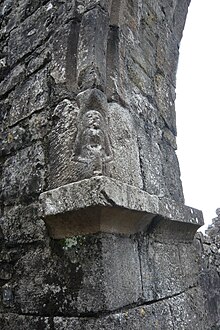|
Fore Abbey
Fore Abbey (Irish: Mainistir Fhobhair) is the ruins of a Benedictine and Early Gaelic 7th century Abbey with associated Mill, Anchorite's Cell, Holy Wells and a structure associated with St. Feichin, all situated to the north of Lough Lene in County Westmeath, adjacent to Fore village. Architectural additions, damage by fire and dismantlement have altered the site's appearance and layout over the centuries. A Gaelic MonasteryThe 7th century abbey was founded by Saint Feichin in 630 CE and functioned for over 400 years till re-founded by de Lacy in around 1200 as a cell of the Abbey of Évreux, now Évreux Cathedral in France as the 'Abbey of SS. Féichín & Taurinus OB'. Fore is the anglicised version of the Irish "Fobhair", meaning "water-springs". The name is derived from St. Feichin's spring or well which is next to the 'old church' (7th century Irish church with cellae), a short distance from the ruined later monastery. The site is referenced in the Annals of Inisfallen (AI) as "Repose of Fechtnach of Fobar".[1] The Ó Cibhleacháin clan were recorded as the coarbs of the Monastery at Fore.[2]

  A Benedictine PrioryIn the 13th century Hugh de Lacy, Lord of Meath had built a Benedictine priory in the valley near the Gaelic Monastery. Many of the buildings that remain today (in ruins) are from the 13th and 15th century and have been restored throughout the 20th century, making Fore Abbey and environs one of the largest group of Benedictine ruins and ecclesiastical landscape to have sojourned and remained in Ireland. This priory was dedicated to both St Féichín and St Taurin, of Évreux, founder of the parent monastery in France. As a cell of a foreign or 'alien' house in the 13th century, the English Crown held the lands and manor owned by the when the English and French were at war with each other.
Seven Wonders of ForeThe abbey is also noted for what locals call the "Seven Wonders":
ConclusionAnother important aspect of Fore is the Fore Crosses one of which is in the village of Fore. There are 18 crosses; some crosses are plain (most likely due to wind and rain erosion) whilst others still remain carved. These are spread out over 7 miles on roadways. The lands associated with the abbey in the middle ages were extensive taking in many of the townlands/parishes around Castlepollard.
Gallery
Wikimedia Commons has media related to Fore Priory. See alsoReferences
|
||||||||||||||||||||||||||||||||||||||||||||
Portal di Ensiklopedia Dunia





